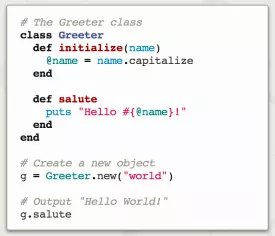Ruby Specifications
Ruby Review

by
Last Updated: 2014-03-26 14:54:05
Inspired by the Perl, Smalltalk, Eiffel, Ada, and Lisp programming languages, Japanese programmer Yukihiro Matsumoto developed Ruby in 1990 with the goal of creating a language that was easier to understand and more logical and practical than those programming languages before it.
Ruby has a dynamic type system which is comprised of dynamic type checking and runtime information. This means that programmers can implement dynamic dispatch, late binding, downcasting, reflection, and similar features into their code. Ruby also has automatic memory management, like Java's trash collector. Memory is automatically allocated where needed in order for the program to run smoothly and as efficient as possible. This is very important for a computer system with multiple processes going at one time.
The history of the language starts back at the naming of it all. The name Ruby was decided after an online chat between Ruby's creator Yukihiro Matsumoto and his co-developer Keiju Ishitsuka. The name choice was between "Ruby" and "Coral." Matsumoto later chose Ruby because it was the birthstone of one of his colleagues.
Matsumoto has often said that he is “trying to make Ruby natural, not simple,” in a way that mirrors life. His primary goal was to minimize confusion for experienced users by following the principle of least astonishment. He wanted a language, first and foremost, that he would enjoy using. The only way he would enjoy using it is if it followed the POLA guidelines.
DOWNLOAD NOW
At the time of downloading Ruby you accept the terms of use and privacy policy stated by Parsec Media S.L. The download will be handled by a 3rd party download manager that provides an easier and safer download and installation of Ruby. Additionally, the download manager offers the optional installation of several safe and trusted 3rd party applications and browser plugins which you may choose to install or not during the download process.







